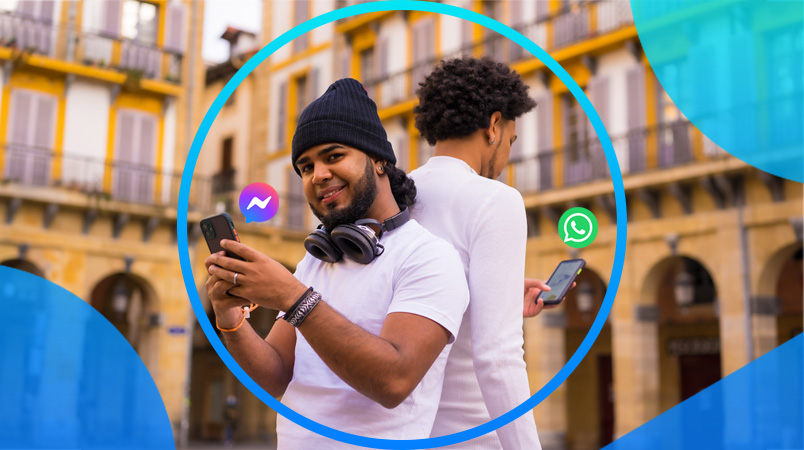Intro: Short Code Messaging for Businesses
Short code (also called short numbers, Common Short Code, or CSC) messaging is commonly used to send business text messages and marketing campaigns to a user’s mobile device. Short code messaging is designed for mass texting and non-personal communications, saving time and money over more traditional methods like calls and emails.
Is using a short code the right SMS delivery strategy for your business? When creating or revising your SMS (Short Message Service) and MMS (Multimedia Messaging Service) strategy, it's essential to understand the basics. Evaluating your communication goals – and identifying the best channels to meet them – are critical components for your long-term success. Let’s dive in and learn more about short codes.
I. What Is a Short Code?
A short code is a specialized five to six-digit phone number used in one-way SMS and MMS messaging. Short code messages convey information to a customer that doesn’t require a response. Conversely, a customer can text a keyword to a business to opt in to marketing messages, vote, or enter a contest.
Short codes are leased monthly, their cost varies depending on the type of short code you choose. Short codes are an alternative to long numbers, full-length phone numbers used to send and receive text messages and calls.
II. Types of Short Codes
There are two types of short codes: shared short codes and dedicated short codes.
Shared Short Code
“Text PIZZA to 13131”
“Text BACON to 13131”
“Text COOL to 13131”
These are all examples of shared short codes. Even though each of these text messages shares a numeric code, they would be routed to separate businesses.
Shared short codes are used and shared between thousands of businesses, making their monthly cost more affordable. Traffic coming into each short code is separated by the use of unique keywords, which enables mobile carriers to distribute short codes among businesses in the same industry.
For example, three bakeries may share a short code 13131, but only one may use ICING as their keyword. The use of keywords is as diverse as the industries that share them, but they must be unique.
Dedicated Short Code
“Text PIZZA to 13131”
“Text PIZZA to 12345”
“Text PIZZA to 54321”
These are all examples of dedicated short codes. Domino’s, Round Table, and California Pizza Kitchen could all use the keyword PIZZA, but texts would be routed to each business based on their short code, not their keyword.
Dedicated short codes are assigned to specific businesses. Since one company absorbs the entire cost of the code, dedicated short codes are more expensive than shared short codes. If you sign up for a shared short code and want to use a keyword that has already been taken, you would have to change to a dedicated short code service.
Within dedicated short codes, there are two subsets: random short codes and vanity short codes.
Random short codes are generic and issued randomly, like a license plate. You have no control over what short code number you are assigned.
Vanity short codes are customized and are the most expensive of all dedicated short codes. The advantage of vanity short codes is that they are the most memorable and can be segmented for your business. You could select a short code that numerically spells the name of your business (like 936397 for Wendy’s), then choose BURGER, FRIES, or FROSTY as keywords to separate your marketing campaigns for that code.
III. Who Uses Short Codes?
Many types of businesses and industries use short codes to communicate with their customers quickly and efficiently, including:
Restaurants
Airlines and travel-related businesses
Shipping companies
Ecommerce marketers
Political polling agencies
Medical and dental offices
Banks and financial institutions
Utility companies
Insurance companies
Schools
Real estate companies and agents
Non-profit and charity organizations
IV. What Are The Benefits of Using Short Codes?
Short codes are attractive for a few key reasons:
Short codes are pre-approved by carriers to avoid spam flags, giving them higher delivery rates than long numbers.
Short codes are easy for customers to remember.
Shared short codes are cost-effective for mass communications.
Shared short codes are fast and easy to set up and have no setup fees.
V. What Are The Risks of Using a Short Code?
Though short codes have high delivery rates and numerous business benefits, there are some risks you should be wary of.
Customers must opt in to receive business texts. Sending unauthorized business texts can result in penalties and fines.
Mass texts and campaigns sent via shared short codes are slower to deliver due to their high volume capacities.
Other users can jeopardize shared short codes by violating the carrier’s established rules. Short code usage can be suspended for up to one month if guidelines are compromised.
Short codes are highly regulated. If you plan on texting customers outside the United States, you’ll have different sets of laws to abide by.
VI. When Should I Use A Short Code?
Businesses can use short codes to promote marketing messages, collect feedback, verify identities, and much more. Some of the most common use cases include:
Notifications and alerts
Voting and polling
Surveys
Sales promotions and special offers
Newsletter and content subscriptions
Contests and giveaways
Discover more ways you can use short codes >>
VII. How Much Does A Short Code Cost?
There are two costs to consider when your business is planning to use a short code:
The cost to lease a short code
The volume-based cost of messages you send from a short code
Short codes are leased monthly. Dedicated short codes are more expensive than shared short codes, costing $750 to $1500 per month depending on the type you choose. If you send messages sparingly or need two-way communication, long codes might be more cost-effective.
VIII. Where To Obtain A Short Code
CM.com has direct connections to hundreds of networks worldwide. Our vast global reach helps us get the most competitive pricing in the short code marketplace for our customers.
Most short codes require carrier approval, which can take 8-12 weeks to process. CM.com manages the approval process for you, facilitating and securing your short code from start to finish.
Speak to our Sales Team to Get Your Custom Quote >>
Continue Our Modern Business Text Messaging Series:









